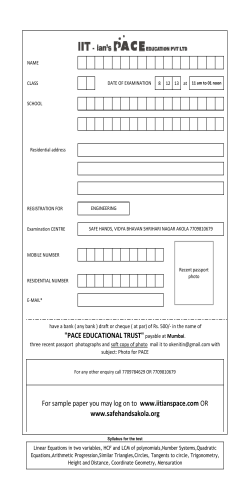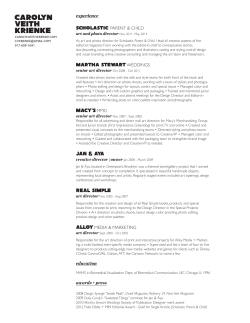
R & A
REPTILES & AMPHIBIANS OF KIRINDY KIRINDY FOREST is a dry deciduous forest covering about 12,000 ha and is managed by the Centre National de Formation, dʹEtudes et de Recherche en Environnement et Foresterie (CNFEREF). Dry deciduous forests are among the world’s most threatened ecosystems, and in Madagascar they have been reduced to 3 per cent of their original extent. Located in Central Menabe, Kirindy forms part of a conservation priority area and contains several locally endemic animal and plant species. Kirindy supports seven species of lemur and Madagascarʹs largest predator, the fossa. Kirindy’s plants are equally notable and include two species of baobab, as well as the Malagasy endemic hazomalany tree (Hazomalania voyroni). Ninety‐nine per cent of Madagascar’s known amphibians and 95% of Madagascar’s reptiles are endemic. Kirindy Forest has around 50 species of reptiles, including 7 species of chameleons and 11 species of snakes. This guide describes the common amphibians and reptiles that you are likely to see during your stay in Kirindy forest and gives some field notes to help towards their identification. The guide is specifically for use on TBA’s educational courses and not for commercial purposes. This guide would not have been possible without the photos and expertise of Marius Burger. Please note this guide is a work in progress. Further contributions of new photos, ids and descriptions to this guide are appreciated. This document was developed during Tropical Biology Association field courses in Kirindy. It was written by Rosie Trevelyan and designed by Brigid Barry, Bonnie Metherell and Monica Frisch. We would like to thank all our TBA alumni and teachers who have allowed us to use their photos for this guide, with special thanks to Marius Burger, Jeremy Holden and Kate Lessells. We also thank Frank Glaw and Miguel Vences. Cover photos: top © Marius Burger; lower left © TBA; lower right © Kate Lessells © Tropical Biology Association 2009 Reptiles and Amphibians of Kirindy CONTENTS Key to bullet points 4 Amphibians Family: Ptychadenidae 5 Family: Microhylidae 5 Family: Mantellidae 6 Reptiles Land tortoises, Family: Testudinidae 9 Freshwater turtles, Family: Pelomedusidae 9 Chameleons, Family: Chamaeleonidae 10 Oplurine lizards, Family: Opluridae 12 Plated lizards, Family: Gerrhosauridae 13 Skinks, Family: Scincidae 14 Geckos, Family: Gekkonidae 15 Boas, Family: Boidae 19 Colubrid snakes, Family: Colubridae 20 Blind snakes, Family: Typhlopidae 26 References 27 Photo credits 27 Snakes 3 Reptiles and Amphibians of Kirindy KEY TO BULLET POINTS (ALWAYS IN THIS ORDER) Size Appearance/distinguishing features Habitat found in/where you’re likely to see it Anurans Tortoises Chameleons Behaviour Geckos Lizards Snakes Diurnal Nocturnal Reproduction Conservation status 4 4 Reptiles and Amphibians of Kirindy AMPHIBIANS 230 species of amphibians have been described in Madagascar, although new species are being identified all the time. Of the three orders of amphibian (Anura, Urodela, Gymnophiona) only anurans (frogs and toads) are represented on Madagascar. 99% of Madagascar’s frogs are endemic, probably due to the isolation the island has experienced. About 4% of the world’s anuran species are found only in Madagascar. FAMILY: PTYCHADENIDAE Ptychadena mascareniensis Males up to 40 mm, females 35 mm. 6‐8 longitudinal ridges running down the back. Feet moderately webbed, hands without webbing. A common species found throughout Madagascar except dense primary rainforest. Active during day and night. FAMILY: MICROHYLIDAE This family is widely distributed over the tropical and subtropical regions of the world. The majority of frogs in Madagascar are from the Microhylidae family. Scaphiophryne calcarata ‘Mocquardʹs rain frog’ Males 20‐27 mm, females 28‐33 mm (one of the smallest Malagasy amphibians). Hands are without webbing, and foot with a trace of webbing. Finger 4 is as long as finger 1 and shorter than finger 2. Shovel‐shaped nose. Uniform dorsum with distinct yellow line down its back. Males have a black throat, while femalesʹ throats are white with brown markings. Often seen in puddles on the main Kirindy trails. Active at night during the rainy season and likely spends the dry season buried underground. Explosive breeders in newly water‐ filled pools and swamps after heavy rains. Photo: © Marius Burger Photo: © Marius Burger 5 Reptiles and Amphibians of Kirindy Dyscophus insularis ‘Antsohy tomato frog’ Males 34‐52 mm, females 37‐46 mm. Hand without webbing. Fingertips are not enlarged. Shovel‐shaped nose. Sides sometimes with a reddish colour, and a light line along the dorsilateral folds. Abdomen uniformly light, with more dark spots in the female than in the male. Burrowing. Explosive breeders in ponds. Photo: © Marius Burger FAMILY: MANTELLIDAE The newly defined family Mantellidae is by far the largest lineage of frogs on Madagascar, including 141 described and many undescribed species. Mantellidae consists of three subfamilies: Boophinae, Laliostominae and Mantellinae. Subfamily: Mantellinae No webbing on feet. The first finger is shorter than or similar in length to the second finger. Have femoral glands (granular structures on femur). Endemic to Madagascar and Mayotte Island. 15 species in this subfamily most of which are brightly coloured and all of which are poisonous. Demonstrate remarkable convergences in appearance, habits and colouration with the neotropical poison arrow frogs (Dendrobatidae). Diurnal. Eggs are deposited outside water. Mantella betsileo ‘Betsileo golden frog’ Males and females 20‐28 mm. Gold diamond on back and black flanks. Underneath is speckled black and blue. Terrestrial species. Eats ants among other things. Calling males show light markings on the vocal sac. Diurnal. Eggs are laid in cavities under rocks and dead trunks. Photo: © Marius Burger 6 Reptiles and Amphibians of Kirindy Subfamily: Laliostominae The first finger is distinctly longer than the second finger. Found in arid habitats. Exclusively terrestrial. Eggs are laid into freestanding, stagnant water Laliostoma labrosum ‘Large‐lipped Madagascar bullfrog’ Photo: © Marius Burger Photo: © Marius Burger Males 44‐56 mm, females 56‐68 mm. Distinct dorsal ridges. Has a fork shaped front. Lives a mostly secretive and subterranean life, but appears on the surface in the rainy season in huge numbers for a breeding frenzy. Explosive breeder in ponds. Aglyptodactylus securifer Photo: © Marius Burger Males 30‐44 mm, females 32‐48 mm. Tibiotarsal articulation reaches snout tip. Head, dorsum, flanks, upper surfaces of legs and arms silvery‐grey to beige. Belly white in the centre and yellow towards the flanks. Black pupil with golden iris. Terrestrial species. An explosive breeder after heavy rains in dry deciduous forest. Breeds in pools or marshy areas, both temporary and permanent, including still pools in dried up riverbeds. Only recorded from a few locations in Madagascar. Probably common in Kirindy but hard to find when not breeding. Threatened by habitat loss. 7 Reptiles and Amphibians of Kirindy Aglyptodactylus laticeps ‘Madagascar jumping frog’ Males 32‐50 mm, females 59‐72 mm. Has a very broad head and snout. Tibiotarsal articulation reaches eye. Terrestrial species. An explosive breeder after heavy rains. Only recorded from Kirindy. Conservation status is Endangered. Photo: © Frank Glaw & Miguel Vences Subfamily: Boophinae The first finger is shorter than or similar in length to the second finger. This subfamily occurs in very dry areas. Largely arboreal. Mainly active at night. Breeds in temporary ponds. Boophis doulioti ‘Morondava bright‐eyed frog’ Males 34‐42 mm, females 39‐52 mm. Enlarged finger pads. Yellow band along flank. Very abundant species. Photo: © Marius Burger Boophis xerophilus ‘Kirindy bright‐eyed frog’ Males 29‐44 mm, females 34‐49 mm. Enlarged finger pads. Distinct pattern on back. Locally common at Kirindy, but threatened by habitat loss in other areas. Photo: © Marius Burger 8 Reptiles and Amphibians of Kirindy REPTILES Madagascar has an incredible diversity of reptiles, and most of the species are found nowhere else. Currently, 346 species are known, of which 314 are endemic to Madagascar. LAND TORTOISES, FAMILY: TESTUDINIDAE Pyxis planicauda ‘Malagasy flat‐tailed tortoise’ Photo: © James H. Harding <150 mm long with males weighing ~ 350g and females up to 680g. Species received its common name from its flattened tail. Aestivates under leaf litter during dry season. Eat mushrooms, fruit, leaves and seedlings. Active during the rainy‐hot season from November‐April. Diurnal. Sexual maturity is reached at 15‐20 years. Mating occurs during this time. Females lay a single egg one month after mating. This is endemic to the Menabe region and conservation status is Endangered. FRESHWATER TURTLES, FAMILY: PELOMEDUSIDAE Madagascar has four species of freshwater turtles. Pelomedusa subrufa Up to 250 mm carapace length. South and West Madagascar (and also found in mainland Africa). Seasonal wetlands and pools. Nest at end of dry season/ beginning of wet season (clutch size about 7 eggs). 9 Reptiles and Amphibians of Kirindy CHAMELEONS, FAMILY: CHAMAELEONIDAE Madagascar has both the biggest and smallest chameleon in the world (Parson’s chameleon and Brookesia respectively) and three genera, Columno, Brookesia and Furcifer are endemic to the island. Chameleons show a high rate of endemism and most species have restricted ranges. They are capable of imitating the shape and colour of their surroundings. Chameleons have a protractable, gluey and very long tongue that allows them to capture prey from a considerable distance. Malagasy chameleons are subject to a large international market associated with the pet trade. The following Malagasy proverb is based on observations of chameleons: “Go about life the way a chameleon walks: face what is in front and look back at what is behind”. Chameleons in Kirindy Furcifer nicosiai Photo: © Marius Burger Photo: © Marius Burger Males are bigger. High parietal crest (crest on head) and no rostral (nose) appendages. Enlarged scales behind eye. Females have pink stripe along flanks and dorsal crest restricted to anterior third of body. Only found in two locations in the western dry forests of Madagascar: Kirindy and Tsingy de Bemaraha. Eats invertebrates. Eggs laid in the ground. Export of Furcifer has been suspended following the recommendations of CITES in 1995. Furcifer oustaleti Photo: © Niklaus Peyer Abundant and widespread in Madagascar and prefers drier forests and disturbed areas. 10 Together with Calumma parsonii, this is the largest chameleon in the world. Males can reach a total length of 680 mm. Females usually half this size. High crest with occipital lobes absent. Horns or other rostral processes are also lacking. Gular and dorsal crests comprise specialized, prominent conical scales and an abdominal ridge is also present. Colour mainly greys and browns (but can vary in different locations with some being reddish or greenish). Females often more colourful than males. Reptiles and Amphibians of Kirindy Furcifer labordi Male Female Photo: © Isabelle Baumgartner Photo: © Karl Lehmann The most colourful chameleon likely to be found in Kirindy. Males up to 130 mm, females up to 83 mm. Males mainly green with a lighter, broken line along the flanks. Diagonal stripes of lighter green or grey sometimes noticeable on sides. Females often have more brown, blue and purplish patches on green body with bilateral spots of reddish violet just behind the head. Diagonal striping similar to male but often more intense. Casque very high in males, low in females. Males have large, laterally compressed rostral process and high crest. Has an astonishing lifecycle where it spends up to ¾ of its life in an egg. After hatching it only lives 4‐5 months. Conservation status is Vulnerable. 11 Reptiles and Amphibians of Kirindy OPLURINE LIZARDS, FAMILY: OPLURIDAE Opluridae is the only endemic lizard family in Madagascar and the Comoros. The nearest relative is probably the South American family Iguanidae (although some people suggest it is the Anolidae). Opluridae consists of two genera, Oplurus and Chalarodon, both of which occur in Kirindy. Oplurus cyclurus and Oplurus cuveiri O. cyclurus 252 mm; O. cuveiri 373 mm. O. cyclurus has tail spines of similar size whilst O. cuveiri has spines of alternating size = intercalated rings of small scales. Both sexes display head bobbing associated with being territorial. Both O. cyclurus and O. cuveiri are recorded from Kirindy. We think it is O. cyclurus around Kirindy camp but further investigation is needed to confirm this. They are arboreal, perching on tree trunks and are sit‐and‐wait predators. Often have a retreat hole to hide from predators – they can inflate their body once within a hole to prevent being extracted by a predator. Oviparous and buries its 2‐5 eggs in the ground or under rocks. Oplurus female digging hole to lay eggs Chalarodon madagascariensis Photo: © Isabelle Baumgartner 12 200 mm in length. Relatively long limbs and fringes on the digits that aid locomotion in loose sand. Males are larger than females and become brightly coloured in the breeding season during the warm rainy months. Terrestrial species that occurs in areas of sparse vegetation and where at least some patches of sand are present. Digs retreat burrows up to 25 cm in depth. The only species in the Chalaradon genus. During rapid movement, Chalaradon becomes bipedal for short distances. Reptiles and Amphibians of Kirindy PLATED LIZARDS, FAMILY: GERRHOSAURIDAE Two species in the Zonosaurus genus are commonly seen around Kirindy camp. The lateral fold on the neck is a distinguishing feature of this genus. Zonosaurus lay eggs under rocks, dead wood or grass tufts. They are insectivorous. The ventral scales are hexagonal and arranged in eight longitudinal rows. Zonosaurus laticaudatus Up to 500 mm total length. Distinguished visually from the other zonosaurs by its longitudinal stripes, as these grow wider towards the neck and fade into it, ending where the head distinctly joins the neck, rather than directly behind the eyes as in the other species. Males can be distinguished in the breeding season by the bright red markings on the throat and sides of the neck and head. Found in both dry and humid habitats. Z. laticaudatus on the left and Z. karsteni on the right Zonosaurus karsteni Up to 400 mm total length. Smaller than Z. laticaudatus. Overall pattern is a coffee brown colour, with two yellow stripes outlined either side in a darker brown running the length of the lateral edges of the dorsum. Males are distinguishable by their broader tail base and more prominent femoral pores. Z. karsteni only found in dry habitats. Z. karsteni above and Z. laticaudatus below 13 Reptiles and Amphibians of Kirindy SKINKS, FAMILY: SCINCIDAE These are commonly known as skinks which are usually short‐legged lizards with relatively long toes. Skinks are found throughout the tropics and the family currently contains more than 1300 species. Skinks show a wide diversity of species and body forms that are the result of adaptation to particular habitats. This association with habitat types has generated marked local and regional endemism. Skinks usually have long, tapering tails that can be shed and regenerated. The Trachylepis genus (previously called Mabuya) is common in Kirindy. Skinks in this genus are mostly diurnal and terrestrial and have well‐developed limbs. They are carnivorous or omnivorous. Trachylepis elegans Trachylepis tandrefana Photo © Kate Lessells Photo © Marius Burger Photo © Marius Burger Photo © Marius Burger Photo © Isabelle Baumgartner Snout to vent length 50‐58 mm. Rectangular sub‐ocular scale. No bold pattern of white spots behind neck. Large oval shape ear opening. Often heavily invested with mites (including under scales behind thighs). Recently described species (Nussbaum, Raxworthy & Ramanamanjato 1999) Photo: © Marius Burger Smaller than T. tandrefana. Distinguishing feature is the red flash behind the neck. Clear stripes on flanks. Greener colour than T. tandrefana. Endemic species. Broadly distributed on Madagascar. 14 Trachylepis dumasi Snout to vent length 55 mm. Smaller than T. tandrefana. Longitudinal row of white spots on the side of the neck, with a coextensive, dark brown or black, dorsolateral stripe above. Golden brown scales over eye. Only in dry habitats in S & W Madagascar. Reptiles and Amphibians of Kirindy GECKOS, FAMILY: GEKKONIDAE The gecko family is the second most species rich group of reptiles in the world, and Madagascar’s most diverse. Geckos are mainly insectivorous, but some such as Phelsuma consume pollen and fruit. All geckos are oviparous and nearly always lay clutches of two eggs. The Geckolepis genus is endemic to Madagascar. An interesting fact about geckos is that they can’t close their eyes so they lick them clean instead! Blaesodactylus (Homopholis) sakalava ‘Sakalava’s velvet gecko’ Up to 140mm in length. Vertical pupils. Photo: © Marius Burger Photo: © Marius Burger Snout to vent length 56‐104 mm. Heavy bodied gecko with scattered dorsal tubercles. Large eyes with vertical pupils. Individual lamellas on toes. The genus Blaesodactylus appears to be the sister taxon of the mainland African Homopholis. Nocturnal and arboreal. Eggs laid in the ground. Photo: © Marius Burger Geckolepis polylepis ‘Fish scale gecko’ Photo: © Niklaus Peyer Up to 70 mm in length. Have distinctive fish‐like scales (the genus is known as ‘fish scale geckos’). Relatively wide toe pads and vertical pupils. Black line from nostril to eye. Photo: © Marius Burger Very fragile skin which they shed easily, probably as an escape mechanism. Nocturnal and arboreal, shelter under bark during the day. Eggs are laid in the soil or in palm frond petioles. 15 Reptiles and Amphibians of Kirindy GROUND GECKOS, GENUS: PAROEDURA The genus Paroedura, ground geckos, is endemic to Madagascar, with thirteen species, mainly found in dry forests. 40‐100 mm snout‐vent length. Some males reach 200 mm long. Large head and eyes, with vertical pupils. Tuberculate dorsal scales and relatively slender tails that often bear spines. P. picta has 4 to 6 rows of lamellae on its toes whilst P. bastardi has only 2 rows of lamellae on its toes (see photo). Commonly seen at night on the forest floor of Kirindy, though they can climb a few metres above the ground. Nocturnal. Photo: © Brigid Barry Paroedura picta ‘ground gecko’ Photo: © Brigid Barry Paroedura bastardi ‘ground gecko’ Photo: © Jeremy Holden 16 Photo: © Brigid Barry Reptiles and Amphibians of Kirindy LEAF TAIL GECKOS, GENUS: UROPLATUS Range from <60 mm snout to vent length to 190 mm. Head large and triangular. Large eyes and vertical pupils. Short tail flattened dorso‐ventrally. Highly cryptically patterned bodies. Small but very numerous teeth (as have all geckos but Uroplatus gets the record!) Genus endemic to Madagascar. Nocturnal. A major threat to Uroplatus species is from over‐exploitation for the pet trade. Uroplatus guentheri Photo: © Jeremy Holden U. guentheri only found in dry forest habitats and is known from only a few fragmented localities in Madagascar. Photo: © Jeremy Holden 17 Reptiles and Amphibians of Kirindy MADAGASCAR DAY GECKOS, GENUS: PHELSUMA 45‐120 mm snout to vent length. They have round pupils. They are various shades of green. Males are more brightly coloured than females. Claws are reduced or absent. Insectivorous, some eat pollen and nectar. Diurnal and arboreal. Phelsuma madagascariensis ‘Madagascar day gecko’ Photo: © Marius Burger Photo: © Marius Burger Total length 220‐280 mm. Reddish stripe from nostril to eye. Green colour with variable numbers of red dots. Inhabits a variety of habitats. Divided into several sub‐species. Phelsuma mutabilis Total length 102 mm. Variable colours, from brown to silvery grey. The tail can be brown, grey, green or turquoise. Black stripe from the nostril through the eye to the neck. Hot dry habitats. Lygodactylus spp. Photo: © Marius Burger Divided lamellae. Round pupils. Diurnal. Small geckos numbering 21 species in Madagascar. 18 Reptiles and Amphibians of Kirindy SNAKES BOAS, FAMILY: BOIDAE The presence of boas on Madagascar is a biogeographical puzzle since there are no boas on mainland Africa or much of Asia. Malagasy boas fall into the genera Sanzinia and Acrantophis which probably diverged from a new world ancestral boid. The Madagascar boas are widely distributed throughout the island. The Boidae produce live young (i.e. they are viviparous) which are at least 1m long. Boas display primitive features such as vestigial legs. Boids also have a heat sensitive pit around the mouth which is used for sensing the heat of other animals whilst hunting at night. The only other snakes to possess this ‘sixth sense’ are the pit vipers (Crotalidae). Acrantophis dumerili ‘Dumeril’s ground boa’ Photo: © Marius Burger Photo: © Marius Burger Adults reach a length of 1.3‐1.5 m. Head dorsally covered in small scales, 4 loreal scales and 11‐16 scales around the eye. Ground‐dwelling. Activity in Kirindy is especially high during the rainy season. Diet is small mammals including the giant jumping rat in Kirindy. Both diurnal and nocturnal. Gestation reported to take between 200 and 241 days, with litter sizes in captivity reaching 6 – 13. Conservation status is Vulnerable. Sanzinia madagascariensis ‘Madagascar tree boa’ Photo: © Nicklaus Peyer Adults reach length of up to 2 m. Weigh 3‐6 kg, females recorded to weigh 13.5 kg. Subspecies vary in colour – green to grayish‐ brown and yellow, orange and brown. Sanzinia is distinguished from Acrantophis by the vertically enlarged labial scales. Semi‐arboreal and tail is prehensile. Diet includes rats, lemurs, frogs and birds. Skin darkens when pregnant increasing heat absorption for developing young. Conservation status is Vulnerable. 19 Reptiles and Amphibians of Kirindy COLUBRID SNAKES, FAMILY: COLUBRIDAE The Colubridae is the most diverse snake family in Madagascar with at least 75 species described so far, and new species are being discovered. The colubrids display some common morphological features that distinguishes them from other snake families. Their ventral scales are well developed, usually as broad as the belly. The head is usually oval shaped with systematically arranged shields. In some species the last few teeth on the maxilla are enlarged and grooved hence these are known as ‘rear‐fanged snakes’. CAT‐EYED SNAKES, GENUS: MADAGASCAROPHIS Madagascarophis is the most common genus of Malagasy snakes. They have vertical pupils and are crepuscular (active at dawn and dusk). Madagascarophis colubrinus ‘Malagasy cat‐eyed snake’ Photo: © Marius Burger Small, rarely exceeding 1000 mm. Pupils are vertical slits and are very large. Has an exceptionally bright sparkling yellow eyeshine at night. Malagasy name ‘marolambo’ means ‘many in the hole’ in reference to the occurrence in holes of ant nests. 20 Venomous HANDLE WITH CARE. Feeds on chameleons, frogs, lizards and rodents. Crepuscular or nocturnal and terrestrial but capable of tree climbing and swimming. Oviparous with a clutch of six eggs. Reptiles and Amphibians of Kirindy ARBOREAL SNAKES, GENUS: STENOPHIS Stenophis citrinus Photo: © Kate Lessells Total length up to 705 mm. Bright yellow colour with comparatively few (50‐57) deep black crossbands leaves no possibility of misidentification. Pupils are vertical with black iris. Nocturnal and arboreal. Viviparous. Very restricted distribution in Madagascar – and Kirindy is one of the few places it is found. HOG‐NOSE SNAKES, GENUS: LEIOHETERODON These are hog‐nose snakes which have upturned, shovel‐like snouts. They are terrestrial and diurnal. During the hotter drier periods, Leioheterodon species will remain completely inactive, preferring to stay underground in burrows. They become active during the rainy season, foraging for amphibians and lizards. They are not considered venomous. Leioheterodon geayi ‘Madagascar speckled hog‐nose snake’ Total length up to 1.4 m. Reddish‐brown to white‐cream in colour. Round pupils. Feeds on lizards and amphibians. These are only found in the arid south‐west of Madagascar. 21 Reptiles and Amphibians of Kirindy Leioheterodon madagascariensis ’Menarana’ in Malagasy L. madagascariensis eating an Oplurus egg [ Photo © Isabelle Baumgartner Largest colubrid in Madagascar, reaching 1.5 m in length. Black in colour with yellow chequerboard pattern. Round pupils. Protruding supraocular scales protect the eyes from blowing dust and sand. Uses neck flattening as a defensive mechanism. Very common on Kirindy trails and around camp when the rains start. Feeds on frogs and birds, and commonly seen eating Oplurus eggs on the Kirindy trails. Oviparous with clutch sizes of 10‐13 eggs. Heavily exported for the pet trade. 22 Reptiles and Amphibians of Kirindy LEAF‐NOSED SNAKES, GENUS: LANGAHA Langaha species are conspicuous because of the scaly projections at the tips of their snouts. In females the projections are broadened at the tip, whereas males have a sharply pointed projection. Males are pale brown or yellowish, whereas females are gray with obscure irregular markings. Very cryptic when moving slowly through tree branches, which it does with a slight swaying motion. Uses rapid flight followed by immobility as an escape tactic. Diurnal and arboreal. Oviparous with clutch sizes of 10‐11 eggs. Langaha madagascariensis ‘leaf‐nosed snake’ Photo © Marius Burger GENUS: ITHYCYPHUS Ithycyphus miniatus Photo © Marius Burger Total length up to 1.7 m. Distinguishing feature is the red tail. Sexually dichromatic – females have a pale brown head, males have a bright red head. Eats lizards and frogs. Local folklore says that they can drop from trees and spike cows (and even people) with their tail. Diurnal and arboreal. Photo © Marius Burger 23 Reptiles and Amphibians of Kirindy GENUS: HETEROLIODON Heteroliodon occipitalis Length up to 325 mm. Brown colour with light brown/cream vertebral stripe ‘collar’. Found in arid habitats. BLACK‐BELLIED SNAKES, GENUS: LIOPHIDIUM The genus Liophidium consists of eight species. Liophidium maintikibo Photo: © Piotr Lukasik This species was described in 2009 using a specimen collected on a TBA course. So far it has only been recorded from Kirindy Forest and nowhere else. Snout‐vent length (of holotype) 205 mm. Tail length 50 mm. Predominantly black ventral side. Broad dark lateral band. 24 Reptiles and Amphibians of Kirindy GENUS: MIMOPHIS Mimophis mahafalensis Total length up to 1000 mm. Individuals may be grey to brown with varying numbers and patterns of stripes. Primarily found in open habitats. Feeds on reptiles and small vertebrates. Diurnal and terrestrial. One of the most widespread snakes in Madagascar. Photo © Kate Lessells Photo © Jeremy Holden 25 Reptiles and Amphibians of Kirindy BLIND SNAKES, FAMILY: TYPHLOPIDAE Blind snakes are found mostly in the tropical regions of Africa, Asia and the Americas. They have a worm like appearance and are adapted to burrowing, usually feeding on ants and termites. The eyes are reduced or absent. They differ from other snakes because there is no difference between the dorsal and ventral scales. Most of these species are oviparous. Currently, 6 genera are recognized containing 203 species. Typhlops arenarius Small, reaching up to 220 mm in length. An unpigmented Typhlops species with a uniformly pink colour. Eyes are small black spots. Found in sandy substrates. Photo: © Nicklaus Peyer Typhlops decorsei Total length up to 600 mm – this is the largest Typhlops from Madagascar. Smooth and shiny with a tube‐shaped body. Eyes relatively large black spots. The head has a shovel shape (used in burrowing). 26 Photo: © Isabelle Baumgartner REFERENCES Franzen, M., Jones, J., Raselimanana, A.P., Nagy, Z.T., DʹCruze, N., Glaw, F., & Vences, M. (2009) A new black‐bellied snake (Pseudoxyrhophiinae: Liophidium) from western Madagascar, with notes on the genus Pararhadinaea. Amphibia‐Reptilia 31:1‐11. Glaw, F. & Vences, M. (2007) A field guide to the amphibians and reptiles of Madagascar. 3rd edition. Vences & Glaw Verlags GbR, Cologne, Germany. Goodman, S.M. & Benstead, J.P. (2003) The Natural History of Madagascar. University of Chicago Press. USA. IUCN Red List of Threatened Species www.iucnredlist.org Nussbaum, R.A., Raxworthy, C.J. & Ramanamanjato, J.B. (1999) Additional species of Mabuya Fitzinger (Reptilia: Squamata: Scincidae) from Western Madagascar. Journal of Herpetology 33 (2): 264‐ 280. PHOTOS The majority of photos in this guide were taken by Marius Burger with additions from Isabelle Baumgartner, Frank Glaw & Miguel Vences, James H. Harding, Jeremy Holden, Karl Lehmann, Kate Lessells, Piotr Lukasik and Niklaus Peyer. We would like to thank them and all our TBA alumni and teachers that have allowed us to use their photos for this guide. 27 The Tropical Biology Association is a non-profit organization dedicated to providing professional training to individuals and institutions involved in the conservation and management of tropical environments. The TBA works in collaboration with African institutions to develop their capacity in natural resource management through field courses, training workshops and follow-up support. European Office Department of Zoology Downing Street Cambridge CB2 3EJ United Kingdom Tel. + 44 (0)1223 336619 Fax. +44 (0) 1223 336676 email: [email protected] African Office Nature Kenya PO BOX 44486 00100 - Nairobi, Kenya Tel. +254 (0) 20 3749986 or 3749988 email: [email protected] www.tropical-biology.org
© Copyright 2025









